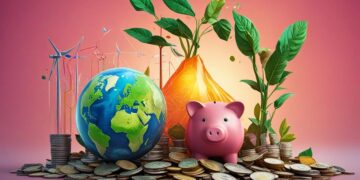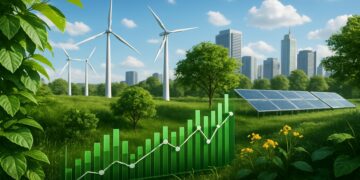How Green Loans Are Transforming Sustainable Project Financing in the United States

The Evolution of Financial Tools for Sustainability
The financial landscape in the United States has seen significant changes as society shifts towards more sustainable practices. Green loans play a crucial role in supporting efforts to reduce environmental impact, allowing individuals and businesses to finance projects that promote sustainability. As awareness of climate issues grows, so does the necessity for funding that aligns with eco-friendly initiatives.
Key Features of Green Loans
Green loans are not just another financial product; they have unique characteristics tailored to support environmentally conscious projects:
- Lower interest rates: Many financial institutions offer competitive interest rates to make eco-friendly ventures more appealing. For example, a homeowner looking to install solar panels might find loans with rates that are 0.5% to 2% lower than conventional loans, making long-term savings more attainable.
- Flexible terms: Green loans can accommodate various project types, from residential upgrades like energy-efficient appliances to extensive infrastructure projects such as wind farms and green buildings. This flexibility allows stakeholders to select financing that best suits their project scope.
- Certification processes: To promote genuine green initiatives, projects may need to meet specific sustainability benchmarks, often verified through certifications. This ensures that funds are allocated to projects genuinely beneficial to the environment.
Impact on Sustainable Project Funding
The rise of green loans significantly influences how sustainable projects are financed in the United States:
- Increased accessibility: Small businesses and homeowners now have a more straightforward pathway to secure funding for upgrades. For instance, a restaurant owner looking to convert to energy-efficient equipment may find it easier to obtain a green loan compared to traditional financing options.
- Integration with state incentives: Many states offer additional programs to magnify the benefits of green loans, such as rebates or tax credits for renewable energy projects. By taking advantage of these state programs, borrowers can significantly reduce their total project costs.
- Encouragement of innovation: As demand for eco-friendly solutions rises, financial backing for research and development in this sector accelerates. Startups focused on sustainable technologies can secure green loans to innovate solutions, which further enriches the market.
Leveraging Green Loans for a Sustainable Future
To maximize the potential of green loans, stakeholders should consider the following practical steps:
- Research available green loan options from various lenders and compare interest rates and terms.
- Understand the specific sustainability criteria that your project must meet for loan approval.
- Combine green loans with state and local incentives to enhance financial support for your project.
- Stay updated on emerging trends within the green finance sector to continuously align your projects with best practices.
By effectively using green loans, individuals and businesses can not only contribute to a more sustainable future but also navigate the complexities of project financing with ease. With the right approach, financing eco-friendly initiatives can become both an advantageous and rewarding opportunity.
DISCOVER MORE: Click here for an easy step-by-step guide
Transforming Access to Funds for Eco-Friendly Projects
The introduction of green loans has transformed the way individuals and businesses can access funding for sustainable projects. This transformation is particularly crucial in a country where environmental concerns are pressing and the need for action is immediate. With the right financial products, stakeholders can turn their sustainability aspirations into tangible realities.
How Green Loans Facilitate Sustainable Investments
Green loans provide a more accessible avenue for financing, fostering eco-friendly initiatives across various sectors. Here are several ways these loans enable sustainable investments:
- Affordability: With lower interest rates, green loans make it financially viable for borrowers to invest in sustainable technologies. For example, a local farmer seeking to implement efficient irrigation systems can benefit significantly from reduced borrowing costs. The savings can be reinvested in further sustainable practices, creating a positive cycle of investment.
- Rapid approval processes: Many lending institutions prioritize efficiency when it comes to green loans. This fast-tracked process allows businesses and homeowners to obtain funding quickly, helping them seize opportunities or mitigate urgent environmental impacts. For instance, a small business might need to replace outdated equipment with energy-efficient alternatives to comply with new regulations; quick access to funds can prevent operational disruptions.
- Tailored financing options: Lenders increasingly offer specialized products designed for different sustainable projects, from residential energy upgrades such as solar panel installations to commercial solar installations. This targeted financing ensures that the unique needs of each project are met, promoting effective use of capital while maximizing environmental benefits.
Steps to Secure Green Loans Effectively
To navigate the landscape of green loans successfully, follow these steps:
- Evaluate your project’s sustainability goals: Clearly define what sustainability means for your project. Consider factors such as reducing carbon emissions, improving energy efficiency, or sourcing sustainable materials. Taking the time to document these goals can provide clarity and direction for your loan application.
- Identify suitable lenders: Research lenders that specialize in green loans. Look for institutions with positive reviews, transparency, and a strong commitment to financing eco-friendly initiatives. Websites that aggregate lender reviews can be a valuable resource in this research.
- Prepare necessary documentation: Compile all relevant project information, including costs, expected energy savings, and any certifications that demonstrate the sustainability of your initiative. This evidence can strengthen your loan application. Providing a comprehensive overview of potential return on investment (ROI) can also appeal to lenders.
- Apply for multiple loan options: To find the best rates and terms, submit applications to various lenders. This strategy increases your chances of securing favorable financing while allowing for competitive offers you can weigh against one another. Be aware that multiple applications can sometimes affect your credit score, so consider timing your applications carefully.
By being proactive and well-prepared, individuals and businesses can leverage green loans to fuel their sustainable projects in an increasingly eco-conscious market. This financial approach not only supports immediate needs but also contributes to long-term environmental goals, making a significant difference in the ongoing battle against climate change. Access to green loans empowers borrowers to act decisively in addressing their sustainability challenges while enhancing their economic resilience.
DIVE DEEPER: Click here to learn more
Exploring the Broader Impact of Green Loans
The ripple effect of green loans extends beyond individual projects and into the broader economic landscape. By directing capital towards sustainable solutions, green loans are fostering innovation, creating jobs, and driving economic growth while simultaneously addressing environmental challenges. This multifaceted impact signals a promising shift in how financial systems can support sustainability initiatives.
Stimulating Innovation in Sustainable Technologies
Green loans indirectly incentivize research and development within the clean technology sector. By providing financial backing for new projects, these loans encourage entrepreneurs and businesses to explore innovative solutions. For instance, a startup focused on developing biodegradable packaging can secure green financing to refine its product. With financial support, they can scale their operations and bring sustainable innovations to market faster.
Creating Jobs and Economic Opportunities
Investments funded by green loans contribute significantly to job creation. When businesses receive funding for eco-friendly projects, they often expand their workforce to accommodate enhanced operations. Moreover, new sectors emerge around renewable energy, energy efficiency, and sustainable practices, further enhancing job growth. For example, the solar energy industry has seen explosive growth due to supportive financial products, creating thousands of jobs in installation, maintenance, and manufacturing across the United States.
Enhancing Community Resilience
Green loans are not just about individual financial transactions; they also play a crucial role in strengthening community resilience. Projects financed through green loans can enhance local infrastructure and contribute to public health. For example, a community might secure a green loan to develop a local green space that reduces urban heat, manages stormwater effectively, and provides recreational opportunities for residents. Such investments can lead to more vibrant, resilient communities that are better equipped to face climate-related challenges.
Leveraging Public and Private Partnerships
Green loans foster collaboration between public institutions and private lenders. For instance, government-sponsored programs often work in tandem with banks to offer green loans that include incentives for borrowers, such as tax rebates or grants. This synergy ensures that financing is accessible to a broader range of projects, making sustainable investments appealing even to those with limited resources. One successful example of this collaboration is the Property Assessed Clean Energy (PACE) financing, which empowers homeowners to fund energy efficiency upgrades without any upfront costs.
Measuring Success and Impact
Another essential aspect of green loans is the emphasis on measurable outcomes. Many lenders require borrowers to report on the environmental impact of their projects, such as energy savings, carbon reduction, and improved sustainability metrics. This return on investment (ROI) monitoring not only ensures accountability but also promotes transparency in the financing process. Stakeholders are increasingly recognizing the value of this data, which further informs future investment decisions, fosters best practices, and encourages the continual flow of capital towards sustainable projects.
In this evolving financial landscape, green loans represent a powerful tool, driving significant change in project financing across the United States. The combined effects of enabling innovation, creating jobs, enhancing community resilience, fostering public-private partnerships, and emphasizing measurable impacts paint a promising picture of a more sustainable and economically viable future.
DISCOVER MORE: Click here for easy application tips
Conclusion
Green loans are revolutionizing the landscape of sustainable project financing in the United States by providing the necessary financial support for initiatives that prioritize environmental responsibility. The adoption of these loans enables businesses and communities to pursue innovative and eco-friendly projects that might otherwise be financially out of reach.
Through targeted funding, green loans stimulate the development of clean technologies and drive job creation across emerging sectors, such as renewable energy and sustainable infrastructure. This not only fosters economic growth but also enhances community resilience, making localities better equipped to handle climate-related challenges.
The collaboration between public and private sectors further amplifies the effectiveness of green loans, ensuring that financing options are accessible and attractive to a wide range of borrowers. By incorporating incentives such as tax rebates, these programs encourage diverse investments while lowering the barriers to entry for individuals and businesses alike.
Measurable impacts play a critical role in advancing green financing, as they promote transparency and accountability in project execution. Stakeholders are gaining insight into the effectiveness of their investments, leading to informed decisions that bolster the continuous flow of capital into sustainable projects.
In conclusion, as the United States continues to grapple with environmental concerns, green loans represent a vital tool in turning financial resources into impactful, sustainable actions. Adopting and promoting this financing model can drive significant progress toward a more sustainable future while addressing urgent economic and ecological needs.

Linda Carter is a writer and financial expert specializing in personal finance and financial planning. With extensive experience helping individuals achieve financial stability and make informed decisions, Linda shares her knowledge on the Take Care Garden platform. Her goal is to empower readers with practical advice and strategies for financial success.





